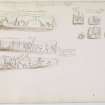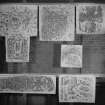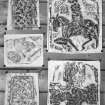Meigle
Cross Slab (Pictish), Pictish Symbol Stone (Pictish)
Site Name Meigle
Classification Cross Slab (Pictish), Pictish Symbol Stone (Pictish)
Alternative Name(s) Meigle Museum; Meigle Stones; Meigle No. 3
Canmore ID 30860
Site Number NO24SE 25.03
NGR NO 2872 4459
Datum OSGB36 - NGR
Permalink http://canmore.org.uk/site/30860
- Council Perth And Kinross
- Parish Meigle
- Former Region Tayside
- Former District Perth And Kinross
- Former County Perthshire
Meigle 3, Perthshire, Pictish cross-slab fragment
Measurements: H 0.41m, W 0.33m, D 0.07mm
Stone type: sandstone
Place of discovery: NO 2873 4460
Present location: Meigle Museum.
Evidence for discovery: when Skene sketched it in the early 1830s, it was built into the wall of the stable court at Kirkhill, with face C visible. Subsequently it was removed and the broken lower edge was cut back to form a tenon, as illustrated by Chalmers and Stuart in the mid nineteenth century. This tenon was later chiselled away for reuse as a building stone.
Present condition: only the top portion survives, on which some of the carving and the edges are damaged.
Description
This fragment belonged to a small grave-marker with a top shaped into a pediment. It is carved in relief on both broad faces, within a plain flat-band moulding. The width and height of face A are spanned by a cross with rectangular terminals and rounded armpits, the whole outlined by a roll moulding. A central roundel contains three spirals and the arms are filled with heavy diagonal key pattern. Below the left arm is part of a double-disc symbol, the surviving disc containing a spiral.
Face C is carved with a solitary warrior riding a horse cantering towards the left. The rider is bearded and has curly hair, and he is armed with a sword and spear. The sword scabbard has a D-shaped chap or protective terminal. He is sitting on a striped saddle-cloth which appears to show a slipper-stirrup in which his left foot is braced, but it may simply be a shoe.
Date: ninth century.
References: ECMS pt 3, 296-7; RCAHMS 1994, 98; Fraser 2008, no 189.2.
Desk-based information compiled by A Ritchie 2018
NO24SE 25.03 2872 4459.
The upper part of a gabled cross-slab was formerly built into the wall of the old parish church (NO24SE 33.00), and the lower part of the stone has been re-shaped on two occasions; the slab now measures 0.41m in height, 0.33m in width and 0.07m in thickness. The cross has rounded armpits and is decorated with key-pattern around a central triple spiral; to the left of the shaft there is a fragmentary double-disc symbol. On the back there is a bearded horseman with a spear, a sword in a scabbard with a chape, and a pointed shoe; his saddle-cloth bears
a striped pattern.
Chalmers, followed by Stuart, illustrated a tenon at the base of the fragment, as though the stone had been refashioned in antiquity in order to fit into a socketed recumbent slab, but the tenon no longer survives, and this feature is thus shown within dashed lines on the accompanying figure.
Information from RCAHMS (JNGR) 1990
P Chalmers 1848; J Stuart 1856.
Publication Account (1964)
No. 3 Upper part of upright cross-slab; decorated on the left of the shaft the top of the double-disc symbol: on the other side, a horseman wearing pointed shoes, armed with spear and sword. Note reins, bridle and saddle-cloth.
S Cruden 1964
















































